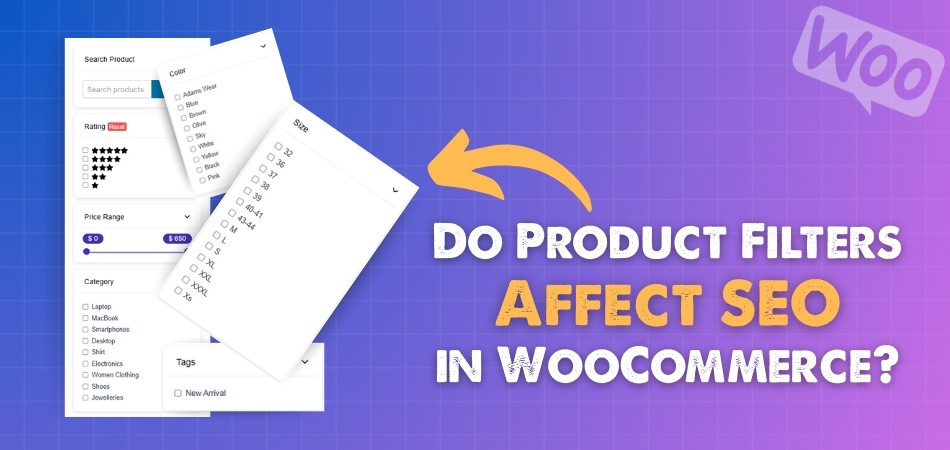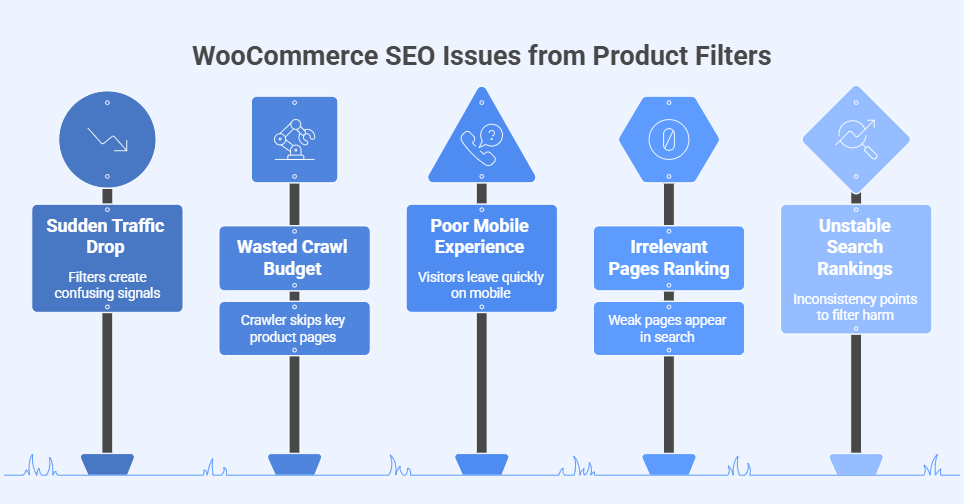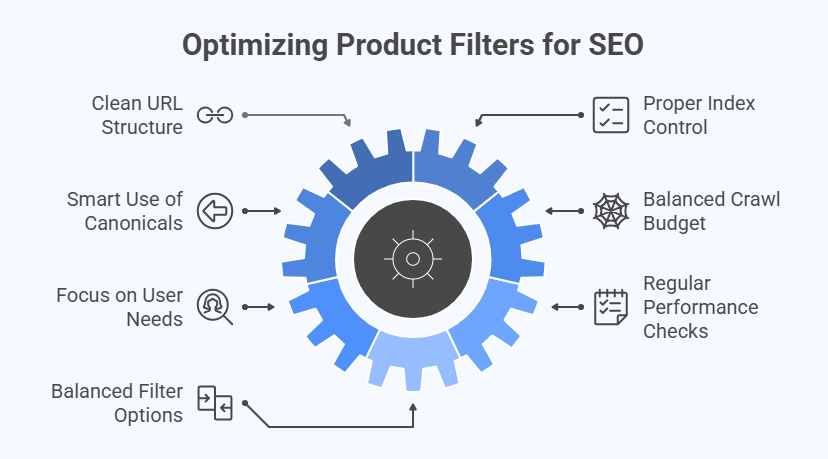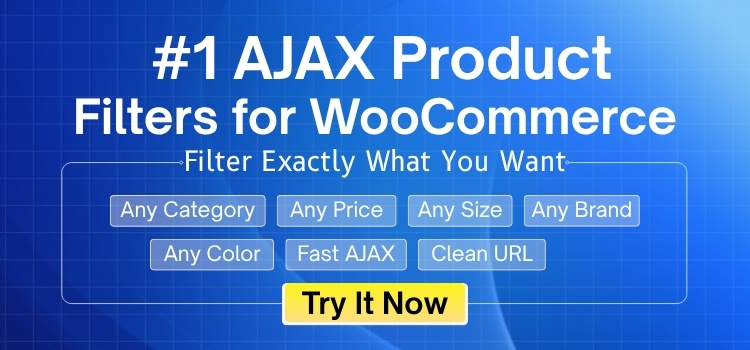SEO in WooCommerce is all about making your store more visible in search results. One part of it that many people notice but don’t think much about is product filters. They seem simple, but they can have a big role in how your store performs online. Because of this, many store owners often wonder, Do product filters affect SEO in WooCommerce?
Yes, product filters can affect WooCommerce SEO in both positive and negative ways. They help users find products faster, but if not used correctly, they can create problems like duplicate content, too many URLs, and wasted crawl budget. When done right, product filters can improve indexing, user experience, and overall rankings in search engines.
Are you curious about how product filters can hurt your store’s SEO if handled poorly, or how they can boost it if used wisely? If yes, then keep reading because this article covers everything you need to know.
Do Product Filters Affect SEO in WooCommerce?
Yes, product filters can affect your WooCommerce store’s SEO in both good and bad ways. They help users find what they want, but if not used correctly, they can create SEO problems too. The way you set them up matters a lot. If done right, filters can even help you rank better in search results. Let’s look below to understand how product filters affect SEO in WooCommerce when implemented in a poor way and in a better way.

Poorly Implemented Product Filters Affect
Too Many URLs
When filters create a new URL for every filter option, it can make your site messy. Search engines may see all those URLs as separate pages, even if they have almost the same content. This can cause confusion and make your store look low-quality to Google. It also eats up your crawl budget, meaning Google might skip your important pages. So, having too many filter URLs is not good for SEO.
Duplicate Content
Product filters can show the same items under different filtered pages. If Google sees the same content on many URLs, it might not know which one to rank. This can lower the visibility of your products in search results. Over time, it can hurt your site’s overall ranking. Duplicate content is one of the most common problems with poor filter use.
Poor Crawl Control
If filters are not managed properly, search engines can end up crawling all the filtered pages. This wastes crawl time and may block Google from seeing your key product or category pages. Search engines might think your site is full of similar and low-value pages. This makes your store look less trustworthy in search rankings. Poor crawl control can quietly hurt your whole website’s SEO.
Slow Page Load
Filters can sometimes make pages load slower, especially if too many filters are selected at once. Search engines don’t like slow websites. A slow site can also make users leave without buying anything. This can increase your bounce rate and lower your rankings. So, slow-loading filter pages can bring both user and SEO problems.
Better Implemented Product Filters Affect
Controlled Indexing
With proper settings, you can tell search engines which filtered pages to index and which to ignore. This keeps your site clean and focused in the eyes of Google. You can use tools like noindex tags or canonical URLs to control this. That way, only the best pages get ranked. Controlled indexing keeps your SEO strong and focused.
Helpful User Experience
Well-set filters help users find what they want fast. This makes them stay longer and browse more products. Search engines notice when people spend more time on your site. A good experience can lead to more sales and better rankings. Filters should help people, not confuse them.
Smart URL Structure
Good filters create simple and clean URLs. For example, using something like shop/shoes?color=black instead of a long, ugly URL. Clean URLs help with Google indexing of filters by making them easier to understand. They also encourage more clicks and shares. This builds trust and supports good SEO.
Fewer but Rich Pages
Instead of creating a page for every filter combo, you can make selected filtered pages into rich SEO landing pages. These can target specific search terms like “black running shoes for men.” With the right title, description, and content, these pages can rank well. It’s all about quality, not quantity.
Signs That Show Product Filters Are Hurting Your WooCommerce SEO
Product filters can make shopping easier, but they may also create hidden problems for your store’s SEO. Sometimes the damage is not clear at first, but certain signs can warn you early. Here are some signs that show product filters are hurting your WooCommerce SEO:

Sudden Traffic Drop
If your site suddenly loses organic traffic, poorly set filters could be the reason. Search engines may push down your important pages if filters create confusing signals. This traffic loss can happen slowly or all at once. Keeping an eye on analytics helps you notice it early.
Wasted Crawl Budget
Search engines have a limit on how many pages they crawl on your site. If filters create endless variations, the crawler wastes time on those instead of key pages. This means your best products may get skipped. Tracking crawl stats can show this problem.
Poor Mobile Experience
Filters that work fine on desktop may be messy on mobile. If they slow down loading or make the site harder to use, visitors leave quickly. High bounce rates from mobile users can lower your SEO value. Mobile-friendly filters are now a must.
Irrelevant Pages Ranking
Sometimes, filtered pages with little or no useful content may appear in search results. These pages confuse visitors and rarely convert into sales. Search engines may downgrade your site if they see too many weak pages. Strong, relevant pages are better for ranking.
Unstable Search Rankings
Filters can create unstable signals for search engines. Your product pages may rank one week and drop the next without reason. This inconsistency often points to filters harming SEO. Stable rankings show your site is well-structured.
Longer Bounce Sessions
If filters take users to empty or irrelevant results, they leave without interaction. Search engines see this as a sign of low-quality pages. The more it happens, the weaker your SEO becomes. Filters must always lead to useful results.
Misleading Analytics Data
Too many extra URLs from filters can cause your analytics to show misleading data. It may seem like there are more pages or traffic than there really are. This makes it harder to measure SEO performance, while a clean filter setup keeps reporting accurately.
Should You Use Product Filter Plugins for SEO Control?
Yes, you should use product filter plugins for SEO control, but only if they are applied in the right way. Some filters make things easier for visitors, but others can create extra problems when not managed the right way. A smart setup helps search engines understand what matters and what doesn’t need attention.

You don’t need to avoid plugins, but choosing the right one is important for better results and fewer SEO mistakes. Many store owners use the WooCommerce AJAX product filter plugin because it offers more control and smooth browsing. It lets you show or hide filtered pages from search engines by setting rules the right way.
The goal is not to block filters, but to use them wisely for cleaner links and more useful product pages. If the plugin gives too many filter options, it might confuse both users and search engines over time. Simple filters, clear URLs, and a good plugin can help your site stay healthy in search rankings. Below are some product filter plugins that help in SEO control:
Dynamic AJAX Product Filters for WooCommerce
This plugin is known for its fast and smooth filtering without reloading pages. It also generates SEO-friendly URLs that search engines can understand. You can set indexing rules to control which filtered pages should appear in search results. This makes it effective for balancing usability and SEO.
WOOF – Products Filter for WooCommerce
WOOF allows advanced filtering by price, categories, attributes, and tags. It also lets you control how filtered results are displayed to search engines. With its options, you can reduce duplicate content problems. This helps search engines focus only on valuable pages.
JetSmartFilters
JetSmartFilters works well with Elementor and offers many filtering styles. It can handle large product catalogs without slowing down the site. The plugin also lets you adjust indexing settings for filtered pages. This makes it easier to manage SEO while improving navigation.
YITH WooCommerce AJAX Product Filter
This plugin is easy to use and offers many customization options. It gives visitors faster results without page reloads. You can control which filter combinations create indexable URLs. This prevents search engines from crawling too many unnecessary pages.
Premmerce WooCommerce Product Filter
Premmerce focuses on performance and SEO-friendly filtering. It creates optimized URLs that search engines can understand better. With simple settings, you can block irrelevant filtered pages from being indexed. This plugin is designed to improve both speed and SEO.
How Do You Maintain Product Filters Without Damaging SEO?
Product filters make shopping easier, but they can also create problems for search engines if not managed the right way. To keep your store healthy in rankings, you need to set them up carefully. Here is how you can manage them without causing SEO issues.

Clean URL Structure
A clear and simple URL structure makes it easy for both users and search engines to understand pages. Long and messy URLs created by filters can confuse crawlers and lower rankings. By keeping URLs short and descriptive, you help your store look more professional. Clean links are also easier for customers to share, which supports better visibility. Consistency in URLs makes filter pages safe for SEO.
Proper Index Control
Many times, not all filter pages deserve to appear in search results. Some filters, like the WooCommerce Price Filter can create dozens of unnecessary URLs. Using noindex or AJAX helps control them without hurting user experience. This way, your most important product and category pages get priority. Managing index control is one of the strongest methods to protect SEO.
Smart Use of Canonicals
Canonical tags are an effective way to tell search engines which version of a page is the main one. When multiple filter pages show similar products, canonicals avoid duplicate content issues. This signals the search engine to rank the right page. By applying them correctly, you can manage filter variations with less risk. It ensures your main category or product pages remain the top priority.
Balanced Crawl Budget
Search engines only crawl a limited number of pages on your site. Wasting this on endless filter URLs leaves important pages unseen. You can manage crawl control by blocking unnecessary filter combinations with robots.txt or using noindex tags. This keeps the focus on core products and categories. Balanced crawling ensures search engines give value to the right parts of your store.
Focus on User Needs
A well-maintained filter system should always serve visitors first. If filters are hard to use or slow down the site, people leave quickly. Search engines notice user behavior, so bad filter design can harm rankings indirectly. By keeping filters fast and simple, customers find products easily. A positive browsing experience boosts both sales and SEO performance.
Regular Performance Checks
Checking filter performance often helps you spot issues before they become bigger problems. Analytics tools can show how filters affect user behavior and SEO. If you notice high bounce rates or unnecessary indexed pages, adjustments are needed. Keeping track ensures filters continue to serve both search engines and visitors. Small corrections over time protect long-term SEO health.
Balanced Filter Options
Offering too many filter choices can overwhelm both visitors and search engines. The goal is to keep only the most useful filters active. Fewer but well-planned filters make the browsing experience smoother and less stressful. They also reduce the chances of creating thin or duplicate content. A balanced filter setup helps maintain a healthy SEO structure.
Best Way to Test a WooCommerce Site’s Product Filter Impact on SEO
Testing the impact of product filters on SEO helps you catch issues before they affect rankings. It also shows what’s working well. Below are smart and simple ways to test your WooCommerce site without harming performance.
- Compare Conversion Rates: See if product filters lead to more completed orders or not. A drop may show users aren’t finding what they need.
- Use Filter-Specific Analytics: Set up tracking to check filter clicks and page visits. This shows how filters affect user flow and product interest.
- Review Bounce Sources: Look at which filtered pages cause quick exits. This shows where users lose interest or find unhelpful results.
- Observe Internal Linking: Filters should not break your internal link structure. Broken or missing links can silently affect how Google understands your site.
- Run Site Health Tools: Use tools like Screaming Frog or Ahrefs to scan for hidden SEO filter issues. These tools catch small problems early.
- Test Filter Combinations: Try different filter pairings and watch the results. Some mixes may break the layout or lead to thin content pages.
- Watch Bot Behavior: Use server logs to see how search bots move through filter pages. Repeated visits to weak URLs may signal a problem.
- Check Filter Accessibility: Make sure filters can be used with keyboard or screen readers. Bad accessibility often leads to lower site quality scores.
Commonly Asked Questions
Product filters in WooCommerce are powerful tools, but they can raise many doubts about how they affect SEO. Below are common questions with clear answers that will help you understand this subject better without confusion.
How Do Product Filters Influence Search Intent?
Product filters allow users to narrow down products by size, color, price, or category. This helps align your store with what people search for in Google. By matching products with intent-driven searches, filters can strengthen relevance. But when filters are poorly structured, they may confuse search engines.
Can Filters Help With Long-tail Keywords?
Yes, filters can create pages that match specific long-tail keywords like “blue cotton t-shirt under $20.” These pages can capture traffic from precise searches. However, not all filter combinations deserve indexing. Carefully selecting which pages to keep indexable ensures you attract relevant long-tail traffic.
How Do Filters Impact Site Authority?
If search engines crawl endless low-value filter pages, they may see your site as less authoritative. Too many thin pages reduce trust. By allowing only valuable filter pages to be indexed, your store maintains authority. Authority helps your core product categories rank stronger.
Which Filters Work Best for SEO?
Filters like price, size, and color often serve both users and search engines well. They create pages with value when indexed carefully. But unnecessary filters like random tags or small details add clutter. Choosing only useful filters helps SEO remain strong.
When Should You Block Filter Pages?
You should block filter pages when they create no unique value for search engines. For example, a filter showing “green shirts in stock” may not add SEO value. Blocking unhelpful filters keeps crawlers focused on your main product categories.
How Do Filters Affect Click-through Rates?
When filters generate clean and relevant pages, they appear more attractive in search results. This boosts click-through rates. But if filter pages show poor titles or irrelevant products, fewer people click. CTR depends heavily on how well filter pages are optimized.
What Role Do Filters Play in User Trust?
Filters play a strong role in user trust because they guide shoppers to the right products quickly. When filters work smoothly, users trust the site more. But confusing filters cause frustration, and lower trust signals can indirectly hurt SEO rankings.
Bottom Line
Product filters may look like small features, but they carry a heavy role in how your WooCommerce store performs in search results. They can either make your store stronger or quietly weaken it without you noticing. Knowing how they work is the first step.
When handled poorly, filters can cause issues like messy URLs, crawling waste, or low-value pages showing up in search engines. But when managed wisely, they can improve user experience, keep indexing under control, and support better rankings. Simple settings and the right plugin make a big difference.
So, Do Product Filters Affect SEO in WooCommerce? Yes, they surely do, and the outcome depends on how you set them up. By keeping filters clean, fast, and well-organized, you’ll enjoy better visibility while giving customers a smooth shopping experience.
